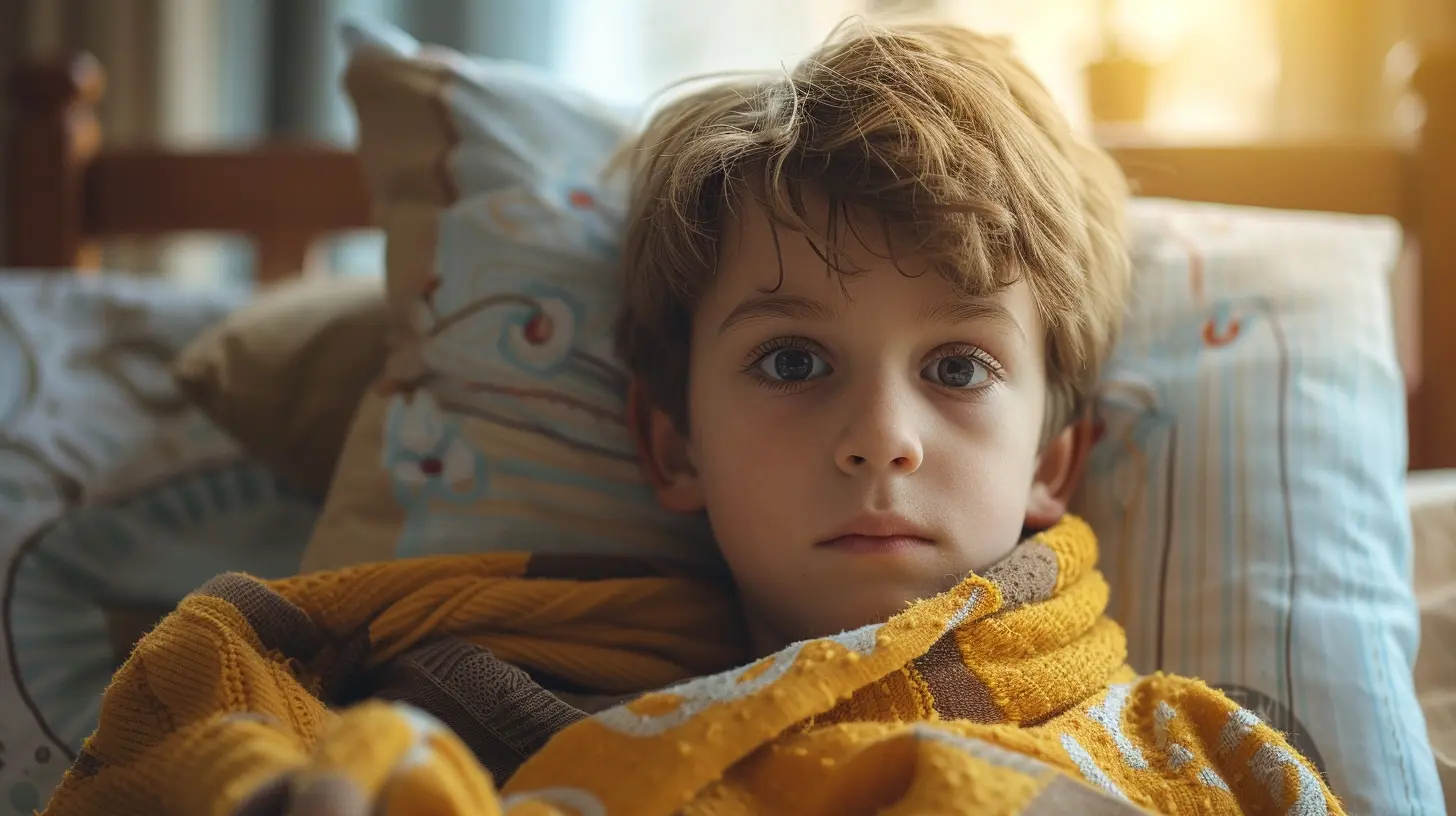Supporting a Child Through Recovery: How to Manage Post-Illness Care
7 October 2025
Watching your child go through an illness is gut-wrenching. No parent wants to see their little one suffer, and once the fever breaks or the cough begins to fade, you breathe that sigh of relief. But here's the thing—just because the symptoms are gone doesn’t mean the recovery journey is over. In fact, post-illness care is where the real healing begins.
Recovery isn’t just about popping antibiotics or finishing meds. It’s a phase packed with emotional ups and downs, physical rebuilding, and yes—lots of patience. In this guide, we'll talk about realistic, effective, and loving ways to help your child bounce back, body and soul.
Why Post-Illness Care Matters More Than You Think
Think of your child’s body like a smartphone battery. After a major illness, it's like their battery’s been drained to 1%. Even if the screen lights up (aka symptoms are better), the power isn’t fully back yet. That’s where post-illness care comes in. It helps recharge their physical and emotional energy, building them back stronger than before.Skipping or rushing this phase can lead to setbacks like relapses, fatigue, or even emotional burnout. Trust me, you don’t want to land back in the doctor’s office because you didn’t give enough time to heal.
Signs That Your Child Is Still Recovering
Sometimes it’s hard to tell if your child is truly back to normal. They may not be running a fever anymore, but that doesn't mean their system is 100%.Here are a few subtle signs they’re still on the mend:
- They tire easily – Can’t play as long as usual? That’s recovery mode in action.
- Appetite isn’t fully back – It might take time for their hunger cues to normalize.
- Mood swings – They might be crankier or more sensitive than usual.
- Clinginess – Sometimes, they just need extra snuggles.
- Sleep disruptions – Illness can mess up sleep cycles, and those don’t always fix overnight.
If you see these signs, be patient. It's your child’s way of saying, “I’m healing, but I’m not there yet.”
Create a Cozy Recovery Environment at Home
After days (or weeks) of being poked, prodded, and surrounded by sterile hospital smells or medicine bottles, your child needs comfort. A stress-free, cozy environment works wonders.Here’s how you can create a healing vibe:
1. Set Up a Quiet, Comfortable Rest Area
Soft blankets, their favorite stuffed animal, maybe even a special “recovery corner” just for them. Think of it as a mini spa retreat—minus the cucumber eyes.2. Dim the Lights and Noise
Recovery isn’t just physical—it’s neurological. Bright lights and loud noises can overwhelm a tired body. Keep things soft and calm.3. Keep Essentials Handy
Tissues, water bottles, books, and calming toys should be within easy reach. The less they have to move, the better.
Focus on Nutrition: Fuel the Recovery Engine
Okay, so this part can be a little tricky—especially if your kid's appetite is all over the place. But nutrition is key to rebuilding strength and boosting immunity.Here’s how to ease back into it:
Easy-On-The-Tummy Foods First
Start with bland, nutrient-dense foods like:- Bananas
- Rice
- Applesauce
- Toast (yes, the BRAT diet still works sometimes)
Once their body starts cooperating, slowly add in:
- Lean proteins (chicken, eggs)
- Whole grains
- Fruits and veggies
- Bone broth (super soothing and nutrient-packed)
Hydration is Non-Negotiable
Kids can become dehydrated quickly during and after illness. Keep pushing water, diluted juices, or even electrolyte drinks. If plain water’s boring, try fruit-infused versions (like tossing in a few berries or citrus slices).Rest, But Don’t Hibernate
Yes, rest is good—but total inactivity for days on end? Not so much.Try to:
- Encourage light movement like stretching or gentle walks
- Let them play quietly for short stretches
- Avoid screens for long periods (eye strain + zapped energy)
Think of energy like money in a piggy bank. Don’t let them spend it all at once, but don’t lock it away either.
Managing Emotions During Recovery
Illness isn’t just hard on the body—it’s tough on the heart too. Kids may feel anxious, clingy, or scared even days after they start feeling better. This is especially true if they were hospitalized or went through a very painful phase.Talk About Their Feelings
Start with open-ended questions like:- “Were you scared when your stomach hurt?”
- “What was the hardest part?”
- “Do you feel different now?”
Validate their feelings. Avoid brushing things off with “You’re fine now!” Even if the germs are gone, the emotional impact might linger.
Offer Comfort and Reassurance
Lots of hugs, patient listening, and even storytelling can help a child feel safe again. Sometimes kids can’t express things directly, so drawing or using puppets can work wonders too. Let them process in their own time.Rebuilding Routine—Slow and Steady
Returning to school, daycare, or even regular homework? That’s gonna need some easing in. Don’t expect them to jump into the deep end right away.Start With Half Days (If Possible)
If they’re going back to school, see if they can start with half-days or a reduced workload. Communicate with teachers—it takes a village.Keep Mornings Calm and Unrushed
Post-illness mornings can be especially rough. Give yourself extra time to avoid stress spirals (they’re real). Go slow, and add in something comforting like a warm breakfast or cuddles.What About Medication and Follow-Ups?
Never, ever skip finishing any prescribed meds—even if they seem 100% better. This is especially critical for antibiotics. Stopping early can lead to antibiotic resistance or a return of the infection.And yep, those follow-up appointments? They're not optional checkmarks. They're essential to:
- Ensure the illness is fully cleared
- Monitor for any complications
- Get the green light for full activity
Watch for Red Flags—A Relapse Can Happen
Unfortunately, some illnesses can bounce back if recovery is rushed. Keep an eye out for:- Fever returning
- Extreme fatigue
- Breathing issues
- New or worsening symptoms
When in doubt? Call your pediatrician. You know your kid best. If something feels off, trust your gut.
Involve Siblings (But Keep It Chill)
If you’ve got more than one child at home, you already know how quickly jealousy and confusion can set in. “Why does he get more cuddle time?” “How come she gets to skip chores?”Here’s a tip: Explain that their sibling is still healing and needs extra love right now. Invite them to help in small ways—reading a book aloud, fluffing pillows, or choosing a recovery snack. It helps them feel useful, not left out.
Be Kind to Yourself, Too
Let’s not sugarcoat this—taking care of a recovering child is exhausting. You’re juggling meds, emotions, meals, and possibly your job. It’s okay to feel drained, even frustrated.Here’s your permission slip to:
- Take naps while they nap
- Order takeout if you’re too tired to cook
- Ask for help (yes, really)
- Skip non-essentials like laundry and vacuuming for a bit
Your well-being directly impacts how well your child heals. You can’t pour from an empty cup, right?
Final Thoughts: Recovery Isn’t a Race
Every child heals on their own timeline. Some bounce back in a few days, others take weeks. And that’s perfectly okay.Focus on the little wins—when they smile again, eat a full meal, or sleep through the night. Celebrate those baby steps because they all lead toward full recovery.
So be the safe space they need. Be the steady hand, the warm hug, the gentle nudge. And give both of you grace as you walk this recovery path together.
all images in this post were generated using AI tools
Category:
Childrens HealthAuthor:

Kelly Snow
Discussion
rate this article
1 comments
Harmony Martin
Thank you for this insightful article. Your practical tips on supporting children during recovery are invaluable for parents navigating this challenging time. I appreciate the thoughtful approach you've shared.
October 17, 2025 at 4:51 PM

Kelly Snow
Thank you for your kind words! I'm glad you found the tips helpful. Supporting children through recovery is so important.


